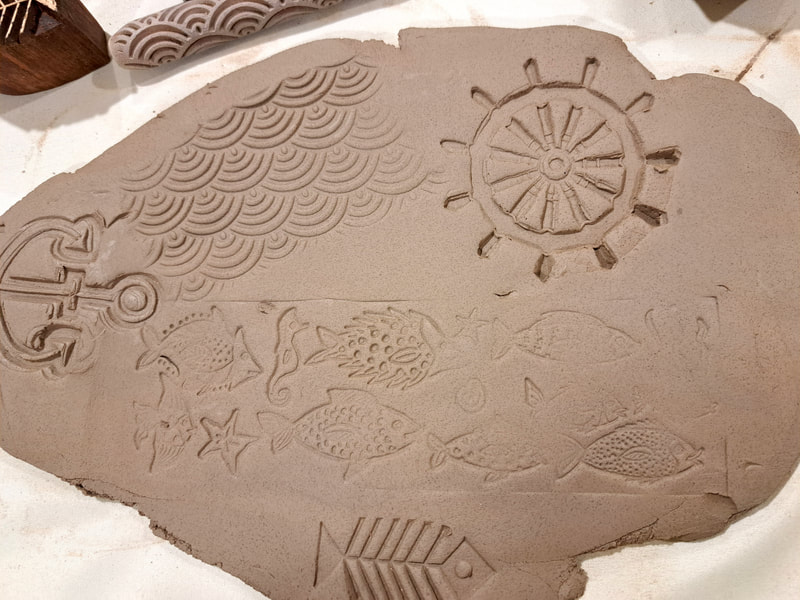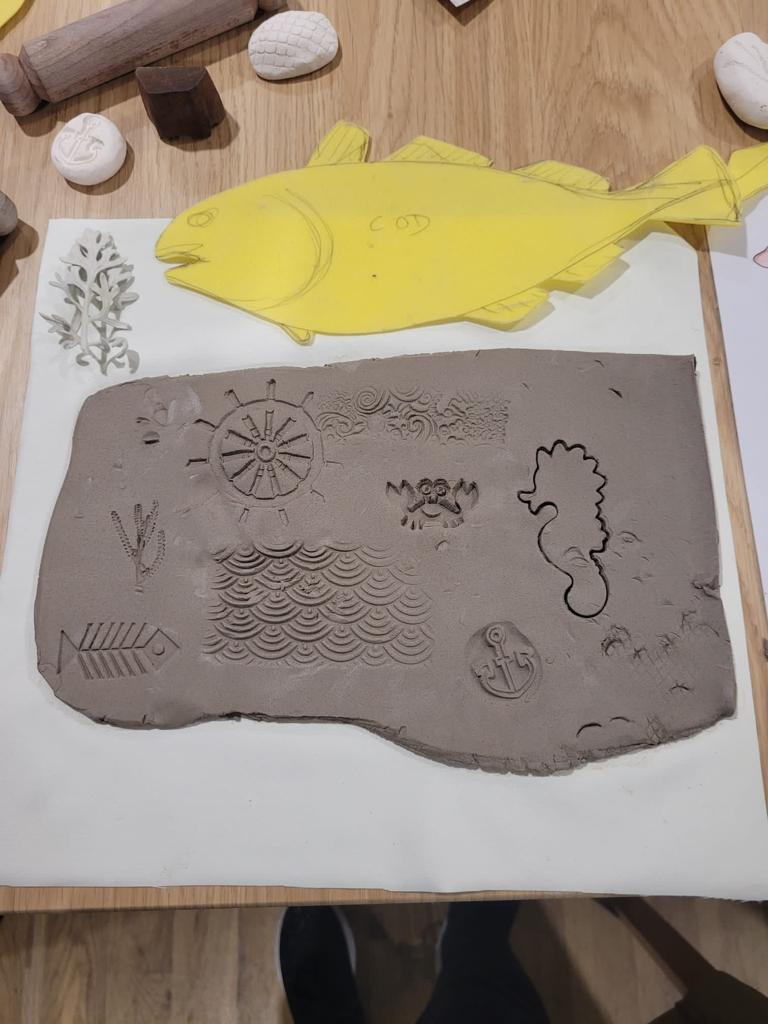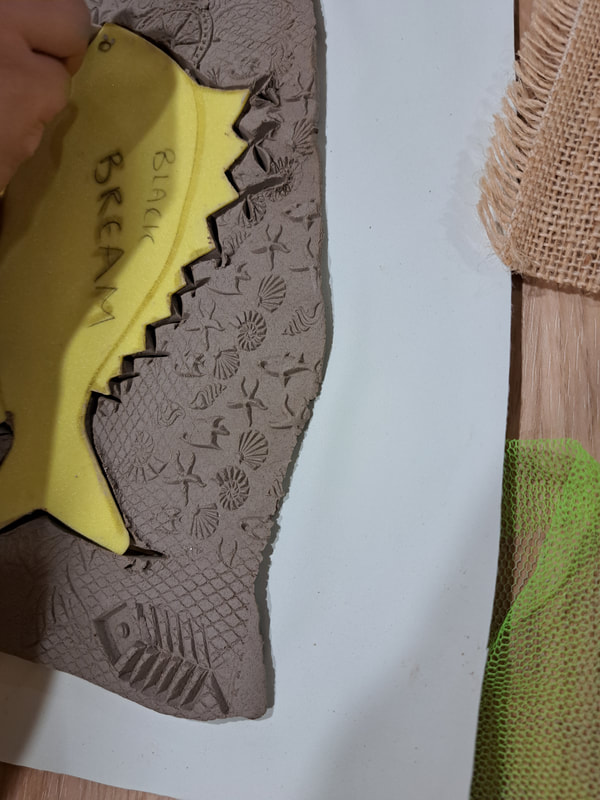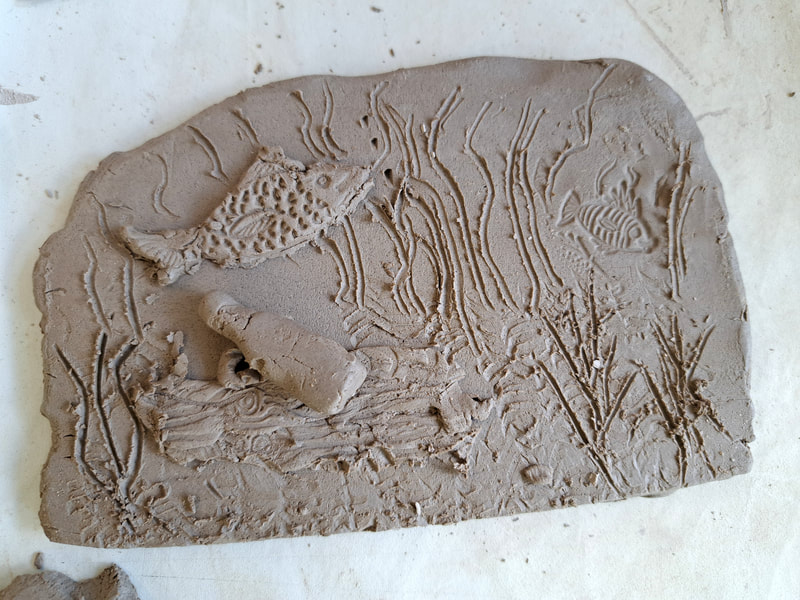My idea was inspired by the shipwreck archives. Participants would each produce a response in clay inspired by the collection. The pieces would be woven together to create a bigger community piece. Either as a stand-alone piece or a few pieces working together to form a narrative about shipwreck archaeology, modern connections, the impact of humans on the sea and what it means to future generations. The focus was on older people in the community. For me, using clay in this project is important as Poole has a rich pottery history with many commemorative pieces made in clay. In the past several pottery factories were in Dorset making tiles, bricks and architectural pieces. Some of which can still be seen in Poole today. Also, clay is a tactile material, suitable for all abilities to use.  Where I started In January 2023 there was an online introduction session to the museums shipwreck collections. This included information and images about the dives to shipwrecks and recovery. Pieces in the collection relating to each shipwreck and the outreach items. The shipwreck archives consist of the Mortar Wreck, Swash Channel Wreck, Studland Bay Wreck and the Logboat. In the February I visited the museum and was able to explore the handling collections which included a life size replica of a cod, ceramics, replica shoe, wood, merman model, pots, pans and models of ships. Museum specialists were on hand to answer questions and help find pieces we could take out into the community. I started to think about the end piece or pieces. I looked at vessel shapes. Would the response be on the inside or outside? Would they be linked with metal or joined together with slip? I wanted to have the separate responses as a patchwork, linked together to tell a story and showing how archaeology is pieced together and fragmented. I was aware space was limited but wanted to have separate pieces made by individuals and groups, coming together to create an installation. To give a sense of the vessel or vessels in the sea I looked at the fish species found around Studland. These include Gurnard, Bream, Mackerel and Cod. Clay fish would swim around the vessels. The more I researched, the more I became interested in the Studland Bay Wreck and the items within it. Finds included a well-worn leather shoe, woven rush matting, comb, part of the ships pump, colourful pottery and ceramic storage containers. I looked for textures to use in the clay, netting to create fish scales, rope, nautical stamps and wood textures. I found some plants that resembled seaweed textures. Communities – The Potteries care home and memory café On 27th June 2023 myself and museum staff and volunteers visited the Potteries care home with shipwreck items. Participants sat round a table and were shown items included the very large life size replica of a cod skeleton and could touch the shipwreck wood and items that had been under the sea. We discussed the fish that would be swimming around the shipwreck. Participants explored the flat pre rolled clay and textures, mark making inspired by the archives. These were cut out into fish shapes selected by the maker. During the whole process there was a lot of reminiscing about the museum, the coast and how the quay used to be. Staying in the same area we had the memory café in the afternoon to make pieces for the vessel. This had low attendance so other residence from the care home joined us. Again, the participants were enthusiastic about the archives and reminisced about Poole. Feedback from both sessions was positive about the experience, especially having the museum visit as they could no longer visit due to health.  Communities – Dorset Blind Association Poole museum staff and volunteers had a separate session with Dorset Blind Association to give a talk with a collection of the shipwreck pieces to be touched and explored. There were two clay sessions on 5th and 19th July at a café in Southbourne the association meets in. A few pieces were brought along in case anyone missed the talk. This included a replica of the shoe found in the shipwreck. One participant noted it was made completely differently to modern shoes and picked up on details of the stitching, joining and sole that I had not noticed. This highlights the importance of having replica items in museums for people to touch and explore. Another important thing that was brought up was having raised maps of the coastline. One lady said her family had tried to explain with difficulty the coastline to her visually impaired husband. Maps by the coast are flat and it is difficult to describe the flow of the coastline and islands, but could be visualised with raised maps. I went back to the studio after the session and created a raised tile of the Poole and Studland coastline with a boat where the wreck was found. In the two clay sessions participants created two tiles each. I hope these will be mounted in the museum so makers can touch and explore their pieces. Participants were asked to think about themselves as future archaeology. “What would you like archaeologists to find in 400 years time that represents you, either in objects or interests?” The second tile is imagining what humans’ impact on the coast now would look like in 400 years and the impact our traces may leave on future generations. The mark making and details on the tiles was beautiful. Some had a positive and some a negative view on our human impact on the future. Many participants had not explored clay before and the feedback was very positive. “Really enjoyed it”. “Relaxing”. “Would like to do more”. Communities – Bourne Valley Hub The last session was at Bourne Valley Hub on 20th July. This is a centre that has a variety of drop-in community sessions including health and wellbeing sessions, food bank, a café and there is a green space outside. In this session more pieces were created to be patchworked together. On one table we had museum archives with a specialist from the museum and another table was set up with clay and tools. We had a range of ages join in. Some people using the hub came and explored the archives, watched makers, but not joining in themselves. Some could have spent the whole day making and productively created a few pieces of the patchwork with details including recreating some of the museum pieces in clay under the sea and even a cannon.  Back at the studio I now had all the community responses in clay. I had made a former to patchwork the pieces into. The former helped to create a vessel shape and hold the pieces in place. Colours and glazes needed to be considered. Pottery found in the Studland wreck had blue and mauve patterns. A bottle found in the bay had a bumpy texture of barnacles. It reminded me of volcanic glazes. These are reactive glazes that have bubbles and pits in them, looking like a volcanic surface. I explored a variety of volcanic glaze recipes fired to 1260 or 1080 degrees. When I found the right glaze, I tried oxides underneath to get variations in colour and also metallic and mossy glazes next to it. After a lot of experimenting the final vessels were decorated with blue and mauve washes inside to highlight textures. Oxides and volcanic glaze on the outside. The tiles also had mauve and blue washes. The fish were coloured in the colours of their species.
1 Comment
|
Deborah ClarkeCommunity ceramicist. Passionate for the Arts to be accessible for everyone. Supportive of local businesses. Archives
January 2024
Categories |



































 RSS Feed
RSS Feed